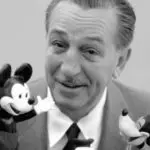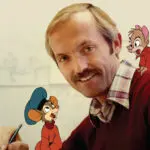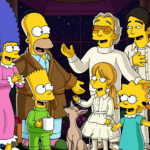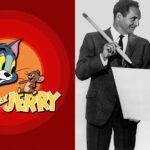Table of Contents
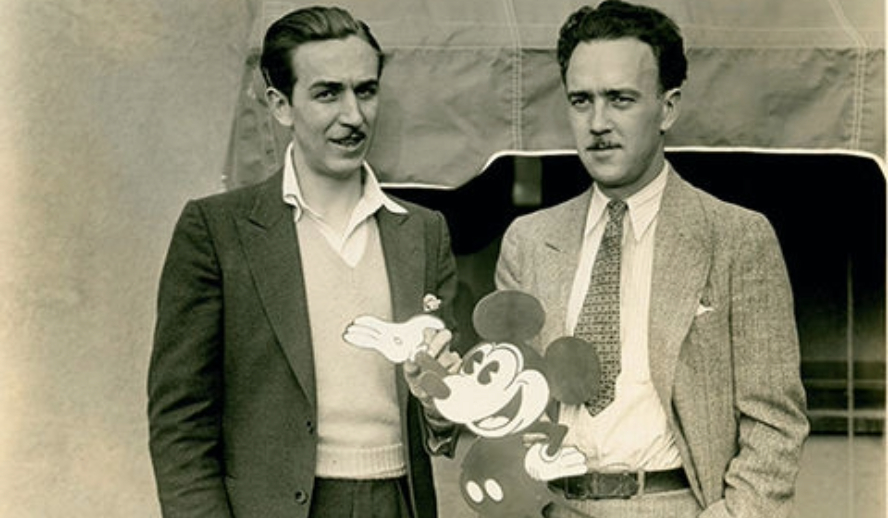
You know Mickey Mouse. I know Mickey Mouse. Everyone knows Mickey Mouse, and that he was created by Walt Disney… right? While that statement isn’t categorically wrong, it’s also not the whole truth. There’s no arguing that Walt Disney was a visionary, but he was not a one man show. Meet Ub Iwerks, the son of a German immigrant, a talented animator, an incredible artist, and a pivotal inventor who altered the course of Hollywood history. Without his contributions to the industry, some of your favorite movies, cartoons, and even theme park attractions may have never been made.
Things to do:
- Subscribe to The Hollywood Insider’s YouTube Channel, by clicking here.
- Limited Time Offer – FREE Subscription to The Hollywood Insider
- Click here to read more on The Hollywood Insider’s vision, values and mission statement here – Media has the responsibility to better our world – The Hollywood Insider fully focuses on substance and meaningful entertainment, against gossip and scandal, by combining entertainment, education, and philanthropy.
The Makings of a Maker
Born Ubbe Ert Iwwerks, our hero was born and raised in Kansas City, Missouri in 1901. His father, an immigrant from Germany that worked as a barber, abandoned the family when Ub was a teenager, which forced him to drop out of school to help support his mother. Apparently, Ub hated the man and never spoke of him. In 1919, he started working at Pesmen-Rubin Art Studio in Kansas City, where he met none other than Walt Disney. Ub and Walt were fast friends and complemented each other well, Walt with his outgoing salesmanship and Ub with his shier, more reserved personality. They teamed up regularly from the very beginning on advertising jobs, with Walt creating the layouts for signs and Ub coming in to do the final polished lettering. This would become a theme as they continued working together over the years.
Ub and Walt were laid off from Pesmin-Rubin after the holiday rush, and after an extremely short stint as “Iwwerks-Disney Commercial Artists” (allegedly because “Disney-Iwwerks” sounded too much like an eyeglasses company), they jumped ship from their fledgling business to work at the Kansas City Film Ad Company, where the pair worked in animation for the first time. Eventually, in 1923, Walt convinced Ub to move out to Hollywood, where animation was on the rise, Iwerks would shorten his name from “Ubbe” to “Ub”, and Walt had secured a contract with Winkler Productions, later Winkler Pictures, to produce the Alice Comedies, a series of shorts following the success of ‘Alice’s Wonderland’ that featured a live-action girl in a cartoon world. This was the real beginning of it all.
WATCH THE TRAILER of the Film and the Revolution: ‘Can I Go Home Now?’
The Children Around the World Continue to Ask the question
The Start of Something Big
Iwerks was the chief animator on the reel that earned Disney the contract with Winkler, and was the most integral member of Disney’s team from the very beginning. His work was the main influence on the lovable look and style of Disney’s early cartoons, and his pace of work eclipsed that of anyone else. Iwerks could produce up to 700 usable animation cels per day, whereas most animators can do around 100 per week. Not only was he fast and talented, he was a teacher and mentor to the younger animators in the studio. As the Alice Comedies neared the end of their run, Winkler requested Disney create a new character for a series of cartoons to revolve around, commissioned by Universal Studios. Thus, Oswald the Lucky Rabbit was born, with Iwerks doing nearly all of the animation for his first appearance, ‘Poor Papa’. Based on feedback from Universal, Iwerks cleaned up Oswald’s look and turned him into the mischievous rabbit we think of today.
If you know anything about the genesis of Mickey Mouse, you’ve probably heard the next act in this story. Disney wanted a raise, Winkler went behind Disney’s back, Universal retained full rights to Oswald, and Disney was left with no distributor, no business for his company, not even a character to call his own. As the legend goes, Disney designs a new mouse character on the train home from that meeting, and his wife names him Mickey. The rest is history, except the part where it was Iwerks who took that sketch and turned Mickey Mouse into the final product audiences would come to love. And, did the lion’s share of the work on Mickey’s first public appearance, ‘Steamboat Willie’, which not only introduced Mickey but was the first fully synchronized sound cartoon. And it was a smash hit, in no small part thanks to Iwerks. He then went on to direct and animate Disney’s experimental Silly Symphonies series, the first being ‘The Skeleton Dance’, an iconic and groundbreaking mix of animation, music, and imagination.
Related article: – Want GUARANTEED SUCCESS? Remove these ten words from your vocabulary| Transform your life INSTANTLY
Related article: A Tribute to Don Bluth: The Animation Auteur Who Commanded Disney to Become Better
Trouble in Paradis(n)e(y)
Even though Iwerks received a lot of internal credit and praise, public praise was pretty limited at Disney. Similar to someone like Edison, everything that went out the door was primarily associated with Walt Disney himself, and other creators rarely got to share that spotlight. Whether this contributed majorly to Iwerks’ decision to go it alone or not, in 1930 he got the chance to start Iwerks Studio with Metro Goldwyn-Mayer as its distributor. At the helm of his own studio, Iwerks created two new characters, Flip the Frog and Willie Whopper, for MGM; produced ComiColor fairy tale cartoons independently; and experimented extensively with multiplane camera animation, which gave his studio’s work incredible depth and perspective. In 1937, Leon Schlesinger Productions (Later Warner Bros. Cartoons) contracted Iwerks to direct four early Looney Tunes shorts featuring Porky Pig and Gabby Goat. On top of all that, he was asked to work on several Color Rhapsody shorts by Charles Mintz, the same person who fired Disney over the Oswald incident and was now trying to imitate the success of Silly Symphonies.
Iwerks’ work was deeply appreciated by other animators and filmmakers, and was highly influential to every studio he touched. Unfortunately, his own enterprise never became the financial juggernaut it would’ve needed to be to compete with the likes of his old stomping grounds. In 1940, he decided to return to Walt Disney Productions, but Disney viewed Iwerks’ departure as a major betrayal of their professional and personal relationship. Animation stalled at the studio for sometime while they attempted to replace Iwerks, but they eventually found enormous success with their first animated feature ‘Snow White and the Seven Dwarves’ in 1937. With the help of Ben Sharpsteen, the director of Disney’s next animated feature at the time ‘Pinnochio’ (1940), Iwerks made his way back into the “House of Mouse”, but not primarily as an animator.
Related article: EVOLUTION: Every Ryan Gosling Role From 1995 to 2020, All Performances Exceptionally Poignant
Related article: EVOLUTION: Every Henry Cavill Role From 2001 to 2021, All Performances Exceptionally Poignant
Related article: The Impact of William Hanna and Joseph Barbera: The Cartoon Kings of the 20th Century
Back in the House of Mouse
In the technical effects department at Disney, Iwerks would do some of his most amazing work. His technical genius with multiplane camera effects evolved into creating the multihead, aerial-image optical printer, and perfecting the concept with which he and Disney had originally found success: mixing animation and live action filmmaking. His technical rigs enabled seamless mixing of animation cels, live action film, visual effects, and auxiliary elements like title cards. As technology in and outside the industry developed, Iwerks applied Xerox technology to the animation process, eliminating incredibly time-costly steps and streamlining cartoon production. His developments in the traveling matte process, essentially layering different filmed elements into the same frames, was pivotal to Disney’s most experimental and successful work all the way into the 1960s. Off-screen, Iwerks was a major contributor to the Disney Parks in the form of Audio-Animatronic engineering and updated special effects for Walt Disney World, but unfortunately passed away mere months before the Magic Kingdom opened in 1971.
Legacy Beyond Disney
Had Ub Iwerks never gotten into animation, it’s hard to imagine that Disney would be the cultural force it is today, or that a lot of different film technologies would have come about as quickly as they did. Iwerks’ signature innovations enabled most of Disney’s early cartoons as well as features like ‘Song of the South’ (1946), ‘Melody Time’ (1948), ‘So Dear to My Heart’ (1949), ‘101 Dalmatians‘ (1961). The twins both played by Hayley Mills in ‘The Parent Trap’ (1961) and the dancing penguin sequences in ‘Mary Poppins’ (1964) were also thanks to Iwerks’ special effects savviness. His printer process was even used by George Lucas for countless special effects sequences in ‘Star Wars’ (1977). Outside of Disney, Iwerks did the special effects for the animated birds in Alfred Hitchcock’s, you guessed it, ‘The Birds’ (1963), for which he was nominated for an Oscar in special effects. The other two times Iwerks was nominated, he won Academy Awards in 1960 for Technical Achievement, and in 1964 for Film Merit, both for his advancements in animation technology. His Imagineering efforts contributed directly to Disney park attractions like Great Moments with Mr. Lincoln, The Hall of Presidents, and of course, It’s a Small World, as well as laying the groundwork for future animatronics on rides like Pirates of the Caribbean and the brand new, technically fantastic Tiana’s Bayou Adventure. Eventually, Ub Iwerks was posthumously awarded the title of Disney Legend.
His legacy extends far beyond Disney productions as well. Chuck Jones was originally hired by Iwerks Studio in the 1930s as a cel washer, but eventually went on to be the creative director for long stretches of ‘Tom and Jerry’ and ‘Looney Tunes’ cartoons, as well as the director of ‘How the Grinch Stole Christmas!’ (1966). And who knows if films like ‘Who Framed Roger Rabbit?’ (1988) or ‘Space Jam’ (1996) would have ever been made without Iwerks’ previous successes in mixing live action film and animation. His technical innovations and imaginative use of special effects enabled future advancements in tech and creative vision, and the world truly wouldn’t be the same without him. Though his legacy is inextricably linked to that of Walt Disney, Ub Iwerks was a force to be reckoned with in his own right, and deserves his own venerated place in Hollywood history.
Click here to read The Hollywood Insider’s CEO Pritan Ambroase’s love letter to Cinema, TV and Media. An excerpt from the love letter: The Hollywood Insider’s CEO/editor-in-chief Pritan Ambroase affirms, “We have the space and time for all your stories, no matter who/what/where you are. Media/Cinema/TV have a responsibility to better the world and The Hollywood Insider will continue to do so. Talent, diversity and authenticity matter in Cinema/TV, media and storytelling. In fact, I reckon that we should announce “talent-diversity-authenticity-storytelling-Cinema-Oscars-Academy-Awards” as synonyms of each other. We show respect to talent and stories regardless of their skin color, race, gender, sexuality, religion, nationality, etc., thus allowing authenticity into this system just by something as simple as accepting and showing respect to the human species’ factual diversity. We become greater just by respecting and appreciating talent in all its shapes, sizes, and forms. Award winners, which includes nominees, must be chosen on the greatness of their talent ALONE.
I am sure I am speaking for a multitude of Cinema lovers all over the world when I speak of the following sentiments that this medium of art has blessed me with. Cinema taught me about our world, at times in English and at times through the beautiful one-inch bar of subtitles. I learned from the stories in the global movies that we are all alike across all borders. Remember that one of the best symbols of many great civilizations and their prosperity has been the art they have left behind. This art can be in the form of paintings, sculptures, architecture, writings, inventions, etc. For our modern society, Cinema happens to be one of them. Cinema is more than just a form of entertainment, it is an integral part of society. I love the world uniting, be it for Cinema, TV, media, art, fashion, sport, etc. Please keep this going full speed.”
More Interesting Stories From The Hollywood Insider
– Want GUARANTEED SUCCESS? Remove these ten words from your vocabulary| Transform your life INSTANTLY
– A Tribute to Martin Scorsese: A Complete Analysis of the Life and Career of the Man Who Lives and Breathes Cinema
– Do you know the hidden messages in ‘Call Me By Your Name’? Find out behind the scenes facts in the full commentary and In-depth analysis of the cinematic masterpiece
– A Tribute To The Academy Awards: All Best Actor/Actress Speeches From The Beginning Of Oscars 1929-2019 | From Rami Malek, Leonardo DiCaprio To Denzel Washington, Halle Berry & Beyond | From Olivia Colman, Meryl Streep To Bette Davis & Beyond
– In the 32nd Year Of His Career, Keanu Reeves’ Face Continues To Reign After Launching Movies Earning Over $4.3 Billion In Total – “John Wick”, “Toy Story 4”, “Matrix”, And Many More

Abigail Whitehurst is an entertainment professional and writer for Hollywood Insider based in Los Angeles, CA. Having lived all over the world as part of a military family and having pursued a bachelors of music, she brings a unique outlook to the entertainment industry. A life-long learner and researcher, Abigail is pursuing her masters in entertainment management. She strives to write through the lenses of context, analysis, and Hollywood Insider’s values to bring a fresh perspective to industry trends, entertainment business, and new film and TV releases. Her favorite place is a movie theater, and she’s always hunting for the deeper meaning and studying media as it pertains to culture. Film, TV, and interactive media are some of the most impactful artforms of our day, and they are worth digging into and analyzing. Everything is connected, whether it’s through Bacon numbers or history. When she’s not writing or at the movies, you can find Abbie crocheting or playing video games with her partner.

